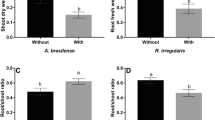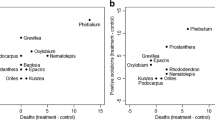Abstract
A series of glasshouse and incubator studies were conducted to investigate the role played by Pythium splendens in a decline disorder of carambola, Averrhoa carambola. Plants, 4–6 months old, were grown in native calcareous soil either infested or not infested with the pathogen. Isolates recovered from atemoya, carambola and passion fruit grew optimally at 30°C, and significantly (P < 0.05) increased root necrosis and reduced root, shoot and total biomass of carambola. Temperature had a profound impact on the latter relationships. Two or more times more necrosis developed at 10 and 15°C than at 25 and 30°C. Total biomass accumulations were over four times greater at 30°C than at 10°C , and were always lower in soil infested with P. splendens. When biomass totals from infested and noninfested soil were compared, relative values were lowest at 15 and 20°C and were almost two times greater at 30°C than at 20°C. Root infection by P. splendens was greatest at 15 and 20°C, far below the species' optimum for growth, and at 30°C was over nine times lower than at 15 and 20°C. This is the first detailed report of P. splendens as a pathogen of carambola.
Similar content being viewed by others
References
Crane JH, Campbell CW, Olszack R. Current statistics for commercial carambola groves in south Florida. Proc Interam Soc Trop Hort 1989; 33: 94–99.
Crane JH, Willis L, Lara SP, Ellenby M. Short-term effects of manual topping of five year old ‘Arkin’ carambola trees. Proc Fla State Hort Soc 1991; 104: 57–60.
Degner R, Stevens T, Mulkey D, Hodges A. Economic impact of agriculture and agribusiness in Miami-Dade County, Florida. Florida Agricultural Marketing Research Center, Industry Report 2000–1 October 2000. Florida Department of Agricultural and Consumer Services, Contract #5218.
Ferriss RS. Effects of microwave oven treatment on microorganisms in soil. Phytopathology 1984; 74: 121–126.
Knight RL. Response of carambola seedling populations to Dade County's oolitic limestone soil. Proc Fla State Hort Soc 1982; 95: 121–122.
Martin FW, Campbell CW, Ruberté RM. Perennial edible fruits of the tropics: An inventory. USDA Agricultural Handbook, No. 642, 1987.
Mitchell DJ, Rayside PA. Isolating, identifying, and producing inoculum of Pythium spp. In: Hickey KD, ed. Methods for evaluating pesticides for control of plant pathogens. St. Paul: APS Press, 1986; 67–70.
Nakasone HY, Paull RE. Tropical fruits. Wallingford, Oxon, UK: CAB International, 1998.
Ploetz RC. Influence of temperature on the development of Pythium splendens-induced root rot of carambola. (Abstr.) Phytopathology 1991; 81: 1242.
Ploetz RC. Species of Pythium as pathogens of perennial, woody fruit crops in south Florida. (Abstr.) Phytopathology 1991; 81: 699.
Van der Plaats-Niterink AJ. Monograph of the genus Pythium. Studies in mycology, Vol. 21. Baarn, The Netherlands: Centraalbureau voor Schemmelcultures, 1981.
Author information
Authors and Affiliations
Corresponding author
Rights and permissions
About this article
Cite this article
Ploetz, R.C. Influence of Temperature on Pythium Splendens — Induced Root Disease on Carambola, Averrhoa Carambola . Mycopathologia 157, 225–231 (2004). https://doi.org/10.1023/B:MYCO.0000020600.61249.06
Issue Date:
DOI: https://doi.org/10.1023/B:MYCO.0000020600.61249.06




